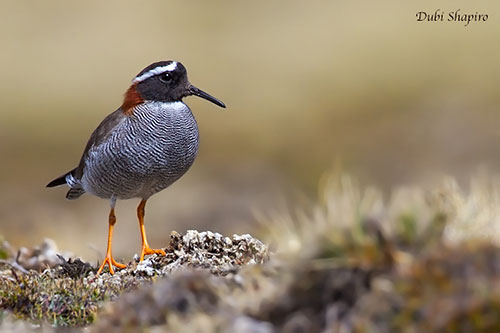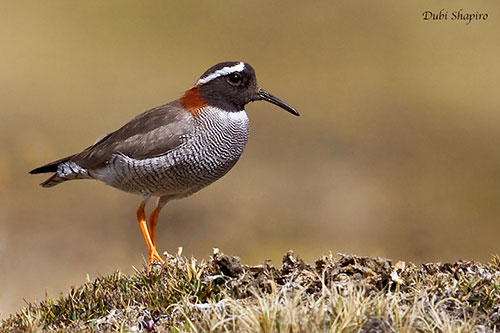
Fr: Pluvier des Andes
Ang: Diademed Sandpiper-plover - Diademed Plover
All: Diademregenpfeifer
Esp: Chorlitejo Cordillerano
Ita: Corriere diademato
Nd: Diadeemplevier
Sd: diadempipare
Photographers:
John Anderson
John Anderson Photo Galleries
Didier Buysse
Vision d’Oiseaux
Dubi Shapiro
Dubi Shapiro Photo Galleries & Dubi Shapiro's Pictures on IBC
Text by Nicole Bouglouan
Sources:
HANDBOOK OF THE BIRDS OF THE WORLD Vol 3 by Josep del Hoyo-Andrew Elliott-Jordi Sargatal - Lynx Edicions - ISBN: 8487334202
SHOREBIRDS by Peter Hayman, John Marchant and Tony Prater – Christopher Helm – 1986 – ISBN: 0747014035
BIRDS OF PERU by Thomas S. Schulenberg, Douglas F. Stotz, Daniel F. Lane, John P. O’Neill, Theodore A. Parker III – Princeton University Press 2007– ISBN: 978-0-691-13023-1
All About Birds (Cornell Lab of Ornithology)
Neotropical Birds – Cornell Lab of Ornithology
Wikipedia, the free encyclopaedia
WADER QUEST – Supporting Shorebird Conservation
A Classification of the Bird Species of South America
Manomet - New Study Sheds Light on Diademed Sandpiper-Plover
Diademed Sandpiper-plover
Phegornis mitchellii
Charadriiformes Order – Charadriidae Family
INTRODUCTION:
This species is also named Diademed Plover, but according to some authors, and especially Alvaro Jaramillo (April 2009), this wader requires a more descriptive name. It has a sandpiper-like bill, but although being fairly similar to the Shore Plover that is also diademed, the present species has longer and finer decurved bill.
The Diademed Sandpiper-plover is endemic to South America and associated with Andean wetlands where it frequents the mossy tundra, grasslands, bogs and swamps at high elevations.
This species breeds between 3,500 and 5,000 metres and nests on the ground during the summer months. It descends to 2,000 metres during winter. It feeds on invertebrates caught by probing the soft soil with the bill.
The Diademed Sandpiper-plover is threatened by degradation of suitable habitats, although its high altitude usual range is probably relatively secure. But the species is currently classified as Near Threatened.

DESCRIPTION OF THE BIRD:
Biometrics:
Length: 17-19 cm
Weight: 28-46 g
The Diademed Sandpiper-plover is a tiny wader with compact body and peculiar long, slightly decurved bill.
The head is dark, blackish-brown to black. The white eyebrows joined by a narrow white band across the top of the crown, form a “tiara” giving the bird its name. Some birds may show some chestnut on the crown too.
On the upperparts, mantle and tertials are dark grey-brown, whereas rest of upperparts is rather grey-brown. On the upperwing, the flight-feathers are dark with narrow, white edges and tips on inner secondaries. On the tail, the central pair of rectrices is dark brown, whereas the others are brown with white spots. The outer pair is barred brown and white.
On the underparts, we can see a pure white band across the lower throat. Rest of underparts is white with narrow dark brown barring on the breast, becoming broader on belly, although being paler with more spaced pattern. On the underwing, coverts and axillaries are white.
The longish black bill (1,6/1,8 cm) is slender and decurved. The eyes are dark brown. Legs and feet are orange-yellow, sometimes paler.
Male and female are similar, but the female is slightly duller.
There is no seasonal variation.
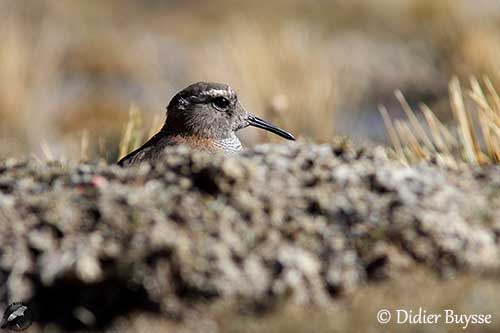
The juvenile lacks the black-and-white head pattern and the chestnut hind collar. The head is dull brown, but we can see a pale posterior supercilium.
The upperparts are dark brown with rufous-buff bars, spots and fringes. The wing coverts show buff tips or bars, but they have a dark subterminal bar.
The underparts are pale brownish-white, and only breast and flanks show some brownish bars.
RANGE:
The Diademed Sandpiper-plover occurs in Andean mountains from NC Peru through N Chile and W Bolivia, to SC Chile and SC Argentina.
HABITAT:
The Diademed Sandpiper-plover is usually found in mossy tundra, wet grasslands, bogs and swamps with cushion plant vegetation, also in gravel or grass on river plains and lake shores.
This species breeds at high elevation, between 3,500 and 5,000 metres in the southern part of the range. During winter, it descends around 2,000 metres.
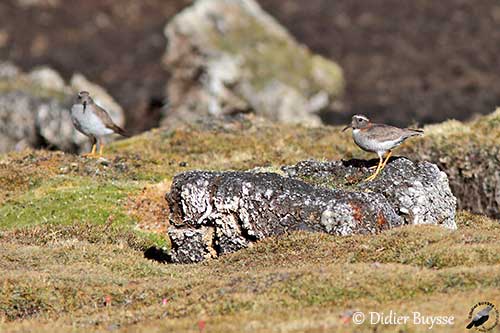
CALLS AND SONGS: SOUNDS BY XENO-CANTO
The Diademed Sandpiper-plover is usually silent, but it may give a penetrating whistle, rather plover-like and low pitched. We can also hear soft contact calls. While foraging and also in flight, it gives some “pic” or “pic-pic” calls. When alarmed, the bird produces loud, screamed whistles “whEEHU”.
BEHAVIOUR IN THE WILD:
The Diademed Sandpiper-plover’s diet is poorly known, but it can be seen probing with the bill held vertically. It probably feeds on insects and other invertebrates caught by gleaning from water surface, soil or aquatic vegetation.
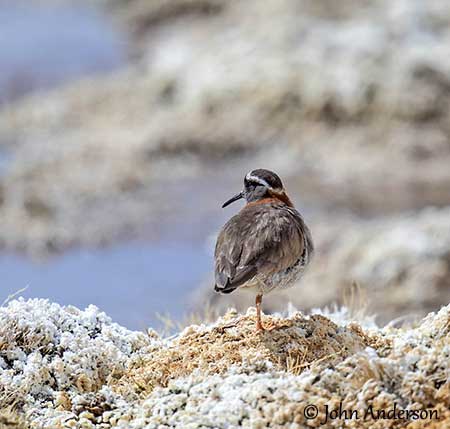
They are often seen in scattered pairs when foraging, but they are not very gregarious.
The courtship displays are unknown. The Diademed Sandpiper-plover nests on the ground on dry, grassy mounds and relatively far from water, but also on small islands in rushing streams. This species breeds at high elevation.
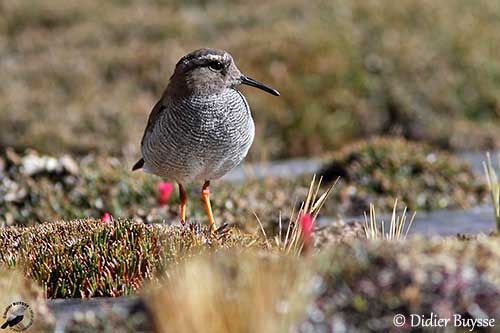
The Diademed Sandpiper-plover of the extreme south of the range usually performs altitudinal movements after breeding in March, although it remains around 2,000 metres of elevation. It returns to the breeding grounds in October.
The flight is fluttering and undulating. The wings are stiff and held slightly below horizontal, while the head is held upright.
REPRODUCTION OF THIS SPECIES:
The Diademed Sandpiper-plover breeds during the austral summer, with the laying in October/December in Chile and in January in Bolivia. It nests at high elevations in the puna zone of the Andes.
It usually nests in isolated pairs. The nest is a circular platform made with dried grass and twigs placed on the ground on dry, grassy mound.
The female lays two olive-grey eggs with dark spots. The downy chicks are dark brown with blacker markings above, and have mainly white underparts. They are accompanied by both parents.
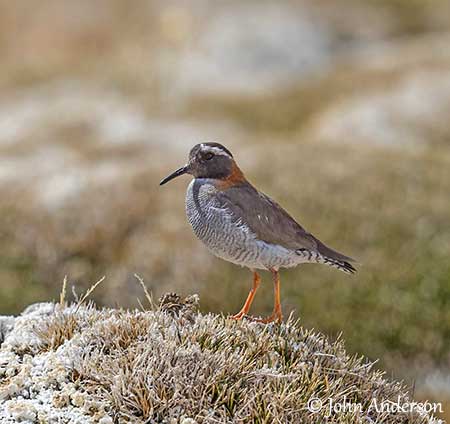
PROTECTION / THREATS / STATUS:
The Diademed Sandpiper-plover is affected by overgrazing, road networks and human disturbance in the high Altiplano in NE Chile. But the habitat at high elevation is probably secure.
The population is estimated at less than 10,000 individuals, equating roughly to 1,500/7,000 mature individuals. It is slowly declining.
The Diademed Sandpiper-plover is currently classified as Near Threatened, due to lack of suitable habitat.
